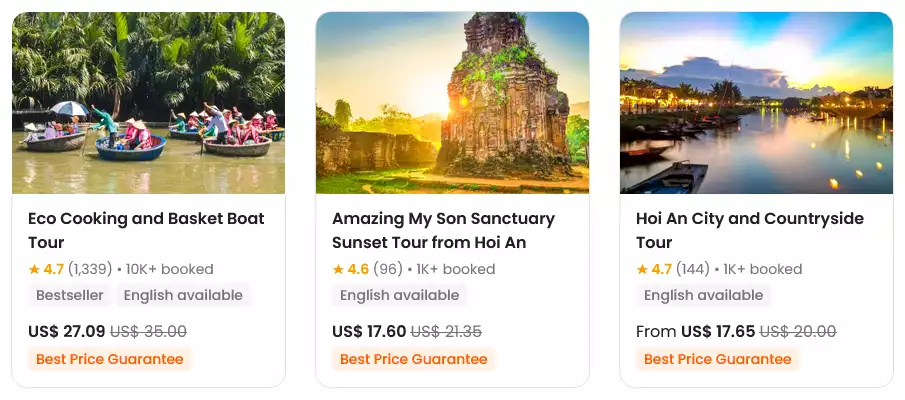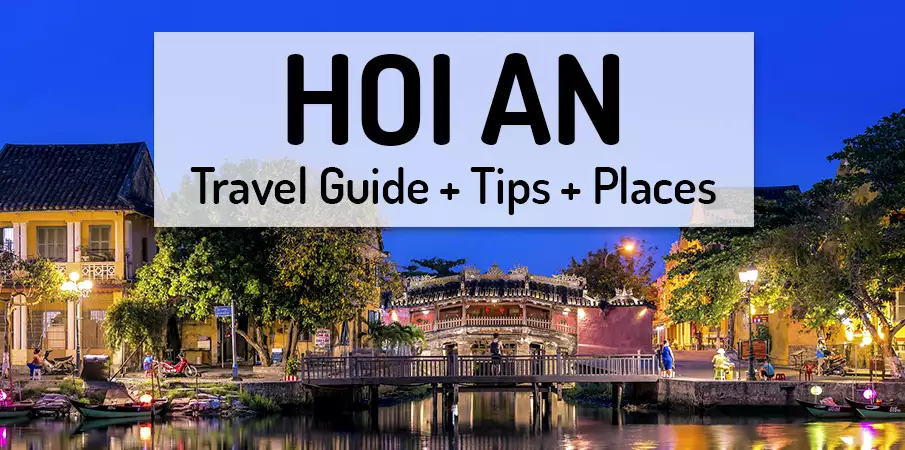
ℹ️ Information – Hoi An
✈️ How to get to Hoi An
☀️ Weather in Hoi An
🏡 Where to stay in Hoi An
🔍 Sightseeing in Hoi An
❓ FAQ + Travel Tips + Info
🎫 Book a Tour in Hoi An
🎫 Book Ticket to Hoi An
Quick answer: Hội An is a charming, lantern-lit ancient town in central Vietnam with rich history, delicious food, and a relaxed vibe. You can stroll its old streets, ride a bike through rice paddies, enjoy a boat ride on the river, and discover both cultural sites and nearby beaches.
At a glance:
- 🌉 Historic Old Town: Walk through narrow lanes, see the iconic Japanese Bridge.
- 🏯 Heritage Buildings: Visit traditional merchant houses and the Museum of Trade Ceramics.
- 🛍️ Night Market & Lanterns: At night, the market by the river glows with lanterns — perfect for food and crafts.
- 🚲 Explore by Bike: Riding through rice fields and nearby villages is relaxing and scenic.
- 🏖️ Beaches: Short ride to An Bang Beach or Cửa Đại Beach for sunshine and sea.
- 🌿 Rural Life: Visit Tra Que Vegetable Village to see farming life and try fresh herbs.
- 🎨 Art & Craft: Visit Kim Bồng woodworking village for traditional Vietnamese carpentry.
- 🍜 Food: Don’t miss cao lầu noodles, white rose dumplings, and banh mi — all local specialties.
- 🕰️ Best Time to Visit: Visit in the dry season (Feb–Aug) for pleasant weather and fewer floods.
Last updated in November 2025
Location and Geography of Hoi An:
-
- Hoi An Ancient Town is situated approximately 30 kilometers south of the city of Da Nang and about 60 kilometers southeast of the ancient imperial city of Hue. The town’s location on the coast and its proximity to the major cities of Da Nang and Hue make it easily accessible to tourists. Visitors can reach Hoi An by plane, with flights landing at Da Nang International Airport, or by bus or train from other parts of Vietnam.
- The geography of Hoi An Ancient Town is characterized by a flat coastal plain, which is traversed by numerous rivers and canals. The town itself is situated on the banks of the Thu Bon River, which flows into the East Sea. The river has played an important role in the town’s history, serving as a transportation route for goods and people and as a source of livelihood for the local fishing communities.
-
- Today, Hoi An Ancient Town’s location and geography continue to attract visitors from all over the world. The town’s well-preserved historic architecture, tranquil riverside setting, and vibrant cultural scene make it a unique and unforgettable destination. Whether you’re interested in exploring the town’s ancient temples and pagodas, sampling local cuisine, or simply soaking up the atmosphere of this charming town, Hoi An Ancient Town is a must-visit destination in Vietnam. And easily accessible from Da Nang city.

A long and fascinating History of Hoi An:
-
- Hoi An Ancient Town has a long and fascinating history that spans over a thousand years. The town’s strategic location on the Thu Bon River made it an important trading hub, attracting merchants from China, Japan, India, and Europe. The town’s earliest recorded history dates back to the 2nd century, when it was known as Lam Ap Pho, a small trading port for the Cham people.
- In the 16th and 17th centuries, Hoi An became a thriving commercial center, thanks to the arrival of European merchants and traders. Dutch, Portuguese, French, and British traders came to Hoi An to trade in silk, spices, and ceramics. The town was also an important center for the production of silk, and its artisans were renowned for their intricate embroidery and weaving.
- Hoi An’s prosperity declined in the 18th century, due to political instability and the silting of the Thu Bon River, which made the town’s port inaccessible to larger ships. The town’s importance as a trading center faded, and it was largely forgotten until the 20th century, when it was rediscovered by tourists and historians.
- Today, Hoi An’s rich history is reflected in its well-preserved historic architecture, which includes Chinese temples, Japanese pagodas, and French colonial buildings. The town’s historic sites have been carefully restored, and in 1999, Hoi An was declared a UNESCO World Heritage site for its unique blend of cultural influences.
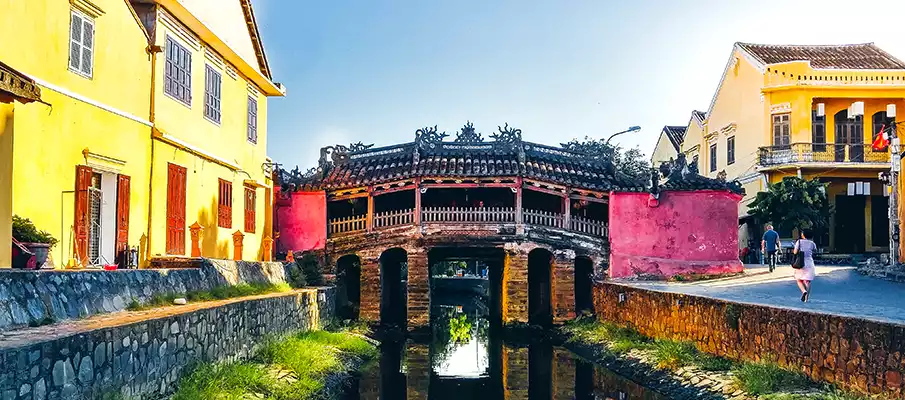
Experience the Rich Cultural Heritage of Hoi An:
-
- The culture of Hoi An Ancient Town is a unique blend of Chinese, Japanese, and European influences, reflecting the town’s long history as a trading center and cultural melting pot. The town’s cultural heritage is evident in its well-preserved historic architecture, traditional festivals and celebrations, and local crafts and cuisine.
- Hoi An is home to a diverse range of cultural and religious traditions. The town has numerous temples and pagodas, including the 17th-century Chua Cau, a Japanese covered bridge that is considered a symbol of Hoi An. Visitors can also explore traditional wooden houses, which are characterized by their ornate carvings and beautiful gardens.
- One of the highlights of Hoi An’s cultural calendar is the Lantern Festival, which takes place on the 14th day of every lunar month. During the festival, the town’s streets are adorned with colorful lanterns, and visitors can take part in traditional activities such as lion dances and boat races.
- Hoi An is also known for its traditional crafts, including silk weaving, pottery, and lantern making. Visitors can see these crafts being made by local artisans and purchase unique souvenirs to take home.
BOOK a TOUR / TICKETS in Hoi An ➜

Experience the Vibrant Festivals of Hoi An:
Hoi An Ancient Town is home to a number of festivals and events throughout the year, offering visitors a chance to experience the town’s vibrant culture and traditions. From traditional Lunar New Year celebrations to modern art festivals, there’s always something happening in Hoi An.
-
- One of the most popular festivals in Hoi An is the Lantern Festival, which takes place on the 14th day of every lunar month. During the festival, the town’s streets are adorned with colorful lanterns, and visitors can take part in traditional activities such as lion dances and boat races.
- Another important festival in Hoi An is Tet, the Lunar New Year celebration, which usually takes place in late January or early February. During Tet, the town is decorated with colorful flowers, and visitors can enjoy traditional food and participate in cultural activities such as calligraphy and lion dances.
- In August, Hoi An hosts the Mid-Autumn Festival, a traditional celebration that honors the moon and the harvest. During the festival, children carry colorful lanterns and enjoy traditional treats such as mooncakes.
- For art lovers, Hoi An hosts the Hoi An International Food Festival and the Hoi An Lantern Festival, which feature live music, dance performances, and food from around the world. The Hoi An Full Moon Festival is also a popular event, featuring cultural performances and traditional games.
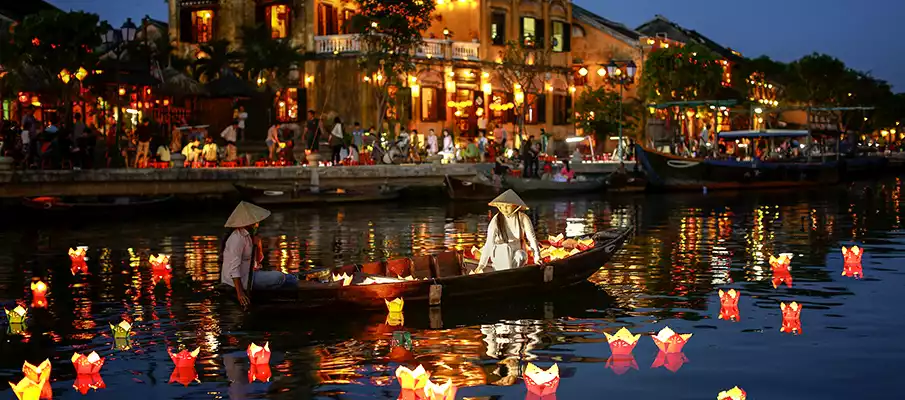
Discover the History and Beauty of Hoi An’s Lanterns:
-
- Hoi An is known for its colorful lanterns, which are an important part of the town’s cultural heritage. The tradition of making lanterns in Hoi An dates back hundreds of years and is believed to have originated from the Chinese influence in the town. Lanterns were used in the past to light up the streets and homes during the full moon festival and other important events. The lanterns were made by hand using bamboo frames and silk or cloth, which were then decorated with traditional designs and patterns.
-
- Today, lantern making is still an important craft in Hoi An, and visitors can see lanterns being made by local artisans and purchase them as souvenirs. The Lantern Festival, which takes place on the 14th day of every lunar month, is a popular event in Hoi An and features colorful lanterns adorning the streets and waterways. Overall, the tradition of lanterns in Hoi An is a testament to the town’s rich cultural heritage and the importance of preserving these traditions for future generations to appreciate and enjoy.
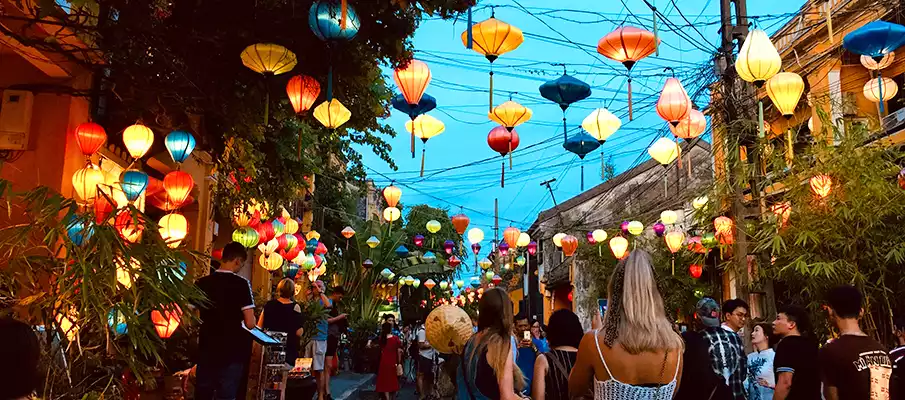
Tourism Drives Hoi An’s Economy: A Delicate Balance:
-
- Hoi An’s economy is driven by tourism, which has become a major source of income for the town’s residents. The town’s rich cultural heritage, ancient architecture, and beautiful landscapes have made it a popular destination for both domestic and international tourists.
- The town is home to many hotels, restaurants, and shops that cater to tourists, and there are also a number of businesses that specialize in traditional crafts such as lantern making, silk weaving, and pottery. Visitors to Hoi An can also take part in cooking classes, bike tours, and other activities that support the local economy.
- In recent years, there has been a push to develop sustainable tourism in Hoi An, with a focus on preserving the town’s cultural heritage and natural environment. This has included efforts to reduce plastic waste, promote responsible tourism practices, and encourage visitors to support local businesses and artisans.
- Overall, tourism has played a crucial role in Hoi An’s economic development, providing employment and income for many of the town’s residents. However, it’s important to balance economic growth with sustainable practices to ensure that Hoi An remains a beautiful and vibrant destination for generations to come.
Book your Accommodation in Hoi An ➜
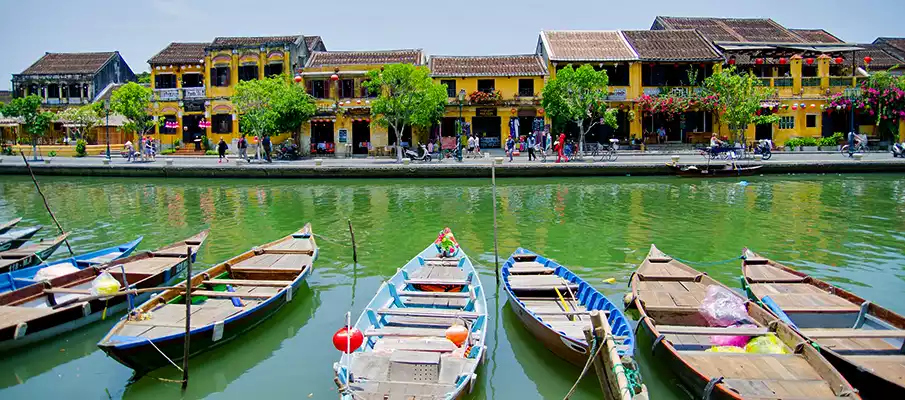
Discover the Beauty of Hoi An’s Tourism Scene:
-
- Tourism is the lifeblood of Hoi An, with millions of visitors coming from all over the world to experience the town’s rich culture, history, and natural beauty. Hoi An has been recognized as a UNESCO World Heritage site, and it’s not hard to see why.
- Visitors to Hoi An can explore the town’s ancient architecture, from the iconic Japanese Covered Bridge to the colorful Chinese temples and shophouses. The town’s old streets are lined with lanterns, and the riverside is dotted with traditional boats that offer a glimpse into Hoi An’s past as a bustling port town.
- In addition to its cultural heritage, Hoi An is also a popular destination for food lovers. The town’s cuisine is a fusion of Vietnamese, Chinese, and European influences, and visitors can enjoy traditional dishes such as cao lau and banh mi, as well as fresh seafood and international cuisine.
- For those who enjoy the outdoors, Hoi An is surrounded by beautiful beaches, lush forests, and scenic countryside. Visitors can take part in activities such as biking, hiking, and kayaking, or simply relax on the beach.

Hoi An Memories Land: A Journey through Time.
Nestled in the heart of the picturesque town of Hoi An, a captivating experience awaits those seeking to immerse themselves in the rich tapestry of history and culture. Hoi An Memories Land, a cultural theme park, is a dazzling showcase of the town’s vibrant past and traditions.
A Journey through Time: Hoi An Memories Land offers a unique opportunity to step back in time and witness the evolution of this charming town. As a UNESCO World Heritage Site, Hoi An boasts a legacy that dates back centuries, and this theme park encapsulates its essence beautifully.
The Attractions in Hoi An Memories Land:
-
- Lantern Garden: Upon entering Hoi An Memories Land, you are greeted by a mesmerizing display of lanterns, a symbol of the town’s enduring charm. These lanterns, which are synonymous with Hoi An, come alive in various colors, creating a magical ambiance.
- Historical Replicas: The park boasts detailed replicas of Hoi An’s most iconic landmarks. Stroll through ancient streetscapes, admire the intricate architecture, and learn about the town’s illustrious history. From the Japanese Covered Bridge to the Fujian Assembly Hall, these recreations offer an immersive history lesson.
- Cultural Performances: One of the highlights of Hoi An Memories Land is the nightly live performance. This spectacular show takes visitors on a journey through Hoi An’s history, featuring dance, music, and dazzling costumes. The performance provides a unique way to understand the local culture and its evolution.
- Culinary Delights: No visit to Hoi An is complete without savoring its delectable cuisine. The park offers an array of dining options, serving authentic Vietnamese dishes. Enjoy local specialties like Cao Lau and White Rose Dumplings while dining in a serene and historical atmosphere.
-
- Preserving Traditions: Hoi An Memories Land plays a vital role in preserving Hoi An’s rich cultural heritage. Through meticulous attention to detail, this park educates and entertains, allowing visitors to appreciate the town’s evolution and enduring traditions.
- Visitor Experience: This captivating destination is suitable for all ages, making it a perfect family outing. Whether you’re a history enthusiast, a culture seeker, or simply looking for an enchanting experience, Hoi An Memories Land has something for everyone.
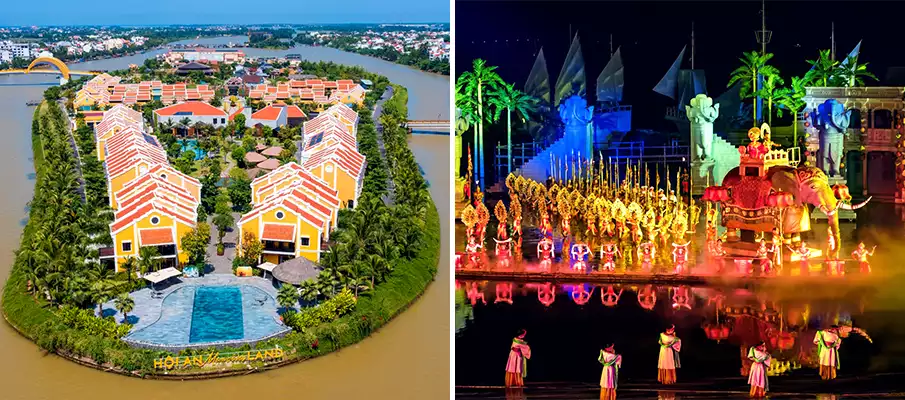
Exploring the Artistry of Thanh Ha Pottery Village in Hoi An:
In the heart of the enchanting town of Hoi An, Vietnam, lies a hidden gem that encapsulates centuries of artistic tradition and cultural heritage – Thanh Ha Pottery Village.
-
- A Pottery Legacy: Known for its rich history in pottery-making, Thanh Ha Pottery Village has been creating exquisite ceramics for generations. This quaint village, located just a short distance from Hoi An’s historic center, is a testament to the timeless craft of Vietnamese artisans.
- The Pottery-Making Process: Visiting Thanh Ha offers a glimpse into the intricate world of pottery creation. Skilled artisans shape and mold clay into a stunning array of pottery, from delicate vases to functional cookware. Witnessing the hands-on process of crafting these pieces is a truly unique experience.
- Interactive Workshops: For those who want to do more than just observe, Thanh Ha offers hands-on pottery workshops. Visitors can roll up their sleeves and get creative, guided by experienced artisans. It’s a chance to learn the art of pottery-making and create your own masterpiece to take home as a memorable souvenir.
- Historical Significance: The village itself is a living museum of Vietnam’s pottery tradition. As you explore the narrow streets and historic houses, you’ll discover the cultural significance of pottery in this region. Each piece tells a story of Vietnam’s history, from practical household items to intricate decorative pieces.
- Aesthetic Delights: Thanh Ha Pottery Village isn’t just about tradition; it’s also about aesthetics. The ceramics created here are renowned for their beauty and craftsmanship. You can explore numerous pottery shops and choose from a variety of exquisite items to add to your collection or as gifts.
Book your Accommodation in Hoi An ➜
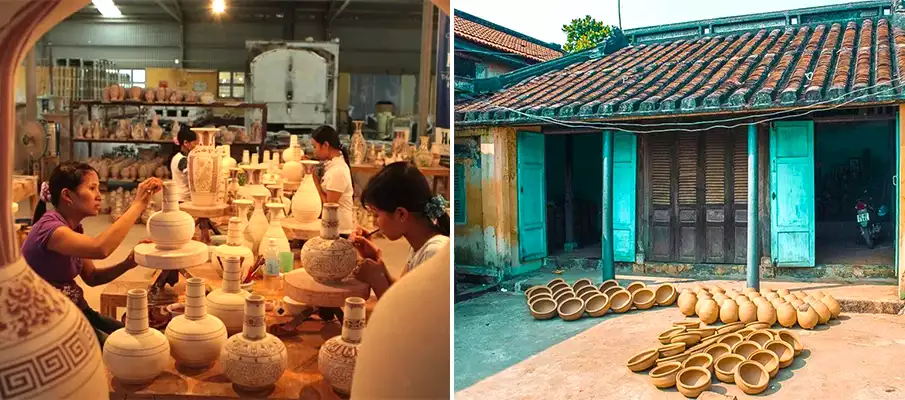
Escape to a bit isolated Cham Islands:
-
- The Cham Islands are a group of eight small islands located off the coast of Hoi An in central Vietnam. The islands are known for their beautiful beaches, crystal-clear waters, and rich marine life, making them a popular destination for snorkeling, diving, and other water-based activities.
- The largest island in the group is Hon Lao, which is home to a small fishing village and several beach resorts. Visitors to the island can explore its rugged coastline, hike through its lush forests, or simply relax on one of its many secluded beaches.
- The Cham Islands are also home to a number of historic sites, including the Hai Tang Pagoda, which dates back to the 18th century, and the ancient Cham ruins of My Son, which are located on the mainland near Hoi An.
- In recent years, there has been a push to develop sustainable tourism on the Cham Islands, with a focus on preserving the islands‘ natural environment and traditional way of life. This has included efforts to reduce plastic waste, promote responsible tourism practices, and support local communities through ecotourism initiatives
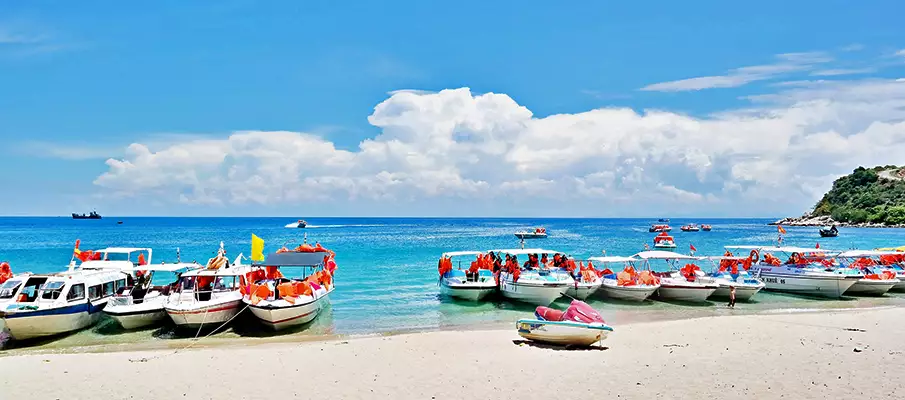
Explore the Beauty of ancient town:
Exploring the beauty of Hoi An’s ancient town is an unforgettable experience that can be enjoyed in many ways. Here are some tips on how to make the most of your visit:
1. Take a Walking Tour: The best way to experience the town’s narrow streets and historic buildings is on foot. Joining a walking tour will give you the opportunity to learn about the town’s rich history and culture, as well as visit some of its most famous landmarks, such as the Japanese Covered Bridge and the Assembly Hall of the Fujian Chinese.
2. Rent a Bicycle: Hoi An is a great place to explore by bike, with many rental shops offering affordable rates. Biking allows you to explore at your own pace and venture off the beaten path to discover hidden gems that you might miss on foot.
3. Take a Boat Ride: Hoi An’s Thu Bon River is an integral part of the town’s history and culture, and taking a boat ride along its banks is a great way to see the town from a different perspective. You can also visit nearby islands, such as the Cham Islands or Cu Lao Cham, by boat.
4. Attend a Cultural Performance: Hoi An is known for its traditional music, dance, and theater performances, which can be enjoyed at various venues around the town. These performances offer a unique opportunity to learn about the local culture and history while being entertained.
5. Experience the Local Cuisine: Hoi An’s food scene is a fusion of Vietnamese, Chinese, and European influences, making it a unique and delicious culinary destination. Take a food tour or simply explore the town’s many street food vendors and restaurants to taste some of the local specialties, such as cao lau and banh mi.
BOOK a TOUR / ACTIVITY in Hoi An ➜
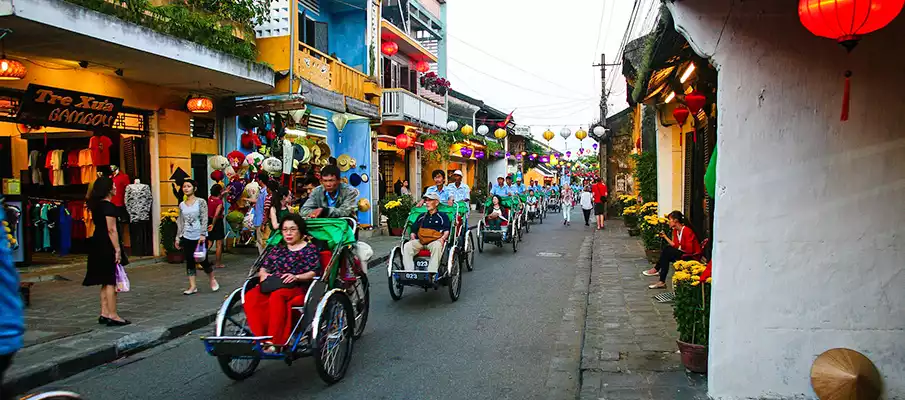
Discovering the Historical Marvels of My Son:
-
- The history of My Son dates back to the 4th century, when it was established as a center of Hinduism in the Champa Kingdom. Over the centuries, more temples and structures were added to the site, many of which were destroyed during wars and natural disasters. Today, the ruins of the temples and towers at My Son are a UNESCO World Heritage Site and a popular tourist attraction.
- To get to My Son, visitors can take a private tour, taxi or motorbike from Hoi An, which is about 50 km away. Alternatively, there are several organized tours available that include transportation, admission fees, and a guide. The trip typically takes about an hour and a half and offers stunning views of the surrounding countryside.
- Once at the site, visitors can explore the ruins and learn about the history and significance of the complex. The temples and towers are known for their intricate carvings and architectural details, and many of them still display remnants of their original red brick facades. My Son is a fascinating and important part of Vietnam’s cultural heritage, and a visit to the site offers a unique insight into the country’s rich history and traditions.
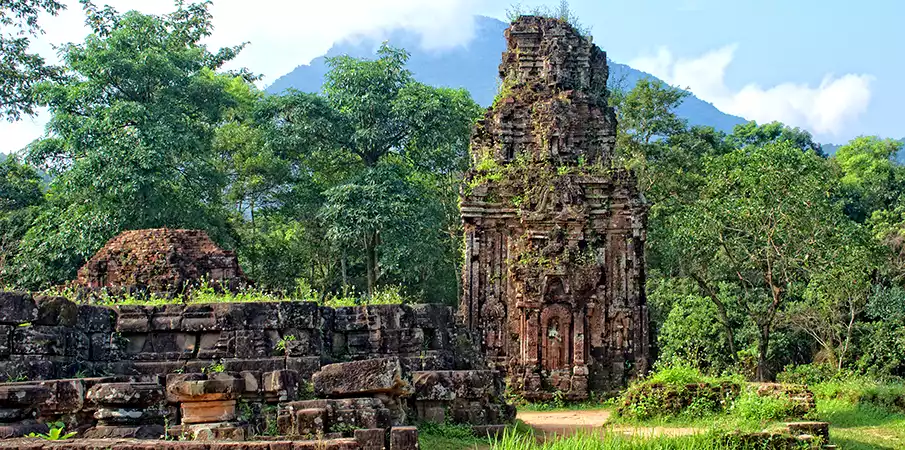
Explore the Magic of VinWonders Nam Hoi An amusement park:
-
- Discover a world of wonder on the vibrant shores of Hoi An, Vietnam, as you step into the enchanting realm of VinWonders Nam Hoi An. This premier amusement park and resort complex is a symphony of excitement and relaxation, designed to cater to every traveler’s desires.
- Thrill-seekers can revel in the heart-pounding excitement of exhilarating rides and water slides at the park’s thrilling water attractions. Meanwhile, culture enthusiasts can dive into the rich tapestry of Vietnamese traditions and heritage.
- Nestled against the backdrop of a pristine coastline, VinWonders Nam Hoi An offers a breathtaking setting where natural beauty meets exhilarating entertainment. Whether you’re planning a family vacation, a getaway with friends, or a solo adventure, VinWonders Nam Hoi An ensures that your visit to Vietnam is nothing short of extraordinary.
- Prepare to embark on a journey filled with magical moments and unforgettable experiences. VinWonders Nam Hoi An is your gateway to a world of adventure and discovery – the epitome of a dream destination. Don’t miss out on the magic; come and explore VinWonders Nam Hoi An today!
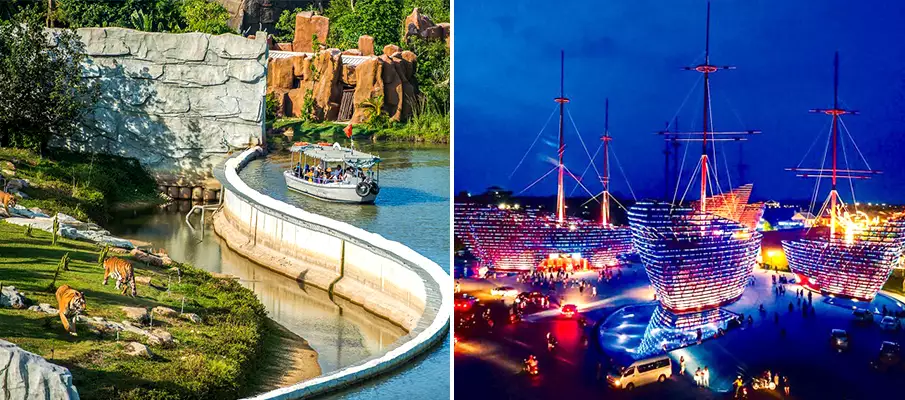
Exploring the Enchantment of Hoi An Night Market.
Hoi An, Vietnam is a town renowned for its timeless charm, where ancient architecture meets the vibrant pulse of daily life. As the sun sets and the lanterns light up, a new world unfolds in the heart of this historical gem. The Hoi An Night Market, a bustling bazaar nestled along the banks of the Thu Bon River, beckons travelers from all corners of the globe to experience its unique blend of culture, commerce, and cuisine.
-
- A Nighttime Spectacle: Hoi An Night Market, with its colorful array of lanterns, is a spectacle to behold. The market comes alive in the evening, transforming the tranquil streets of the ancient town into a vibrant hub of activity. The radiant glow of lanterns adorns the facades of buildings and gently illuminates the river, creating a mesmerizing ambiance that leaves visitors spellbound.
-
- Shop Till You Drop: One of the main attractions of the Hoi An Night Market is its shopping opportunities. From traditional Vietnamese clothing and accessories to handmade crafts and souvenirs, there’s an array of items to suit every traveler’s tastes. The market offers a unique shopping experience with goods that are often locally made and, at times, even customizable to your preferences.
-
- Culinary Delights: Food enthusiasts will find themselves in paradise at the Hoi An Night Market. The aroma of Vietnamese street food wafts through the air, tempting visitors to sample local delicacies. From savory Pho and Banh Mi to sweet treats like Banh Xoai (mango cake) and Che Bap (corn pudding), this market is a gastronomic adventure waiting to be explored. Be sure to try the delectable Cao Lau, a Hoi An specialty known for its unique combination of noodles, herbs, and crispy croutons.
-
- Local Culture on Display: The night market is more than just a place to shop and dine; it’s also a window into the local culture. You’ll find artisans and street performers showcasing their talents, from traditional musical performances to the intricate art of lantern-making. Engaging with these artisans offers a deeper understanding of the cultural richness that Hoi An has to offer.
-
- The Riverside Experience: One of the market’s most charming features is its riverside location. After a day of exploration, you can unwind by the Thu Bon River and enjoy the serenity of the water, the soft rustle of the wind, and the mesmerizing reflection of lanterns on the surface. The riverbank is a popular spot for visitors to relax, chat, and simply soak in the enchanting atmosphere.
Tips for a Memorable Visit:
- Go Early or Late: The market gets crowded in the evening, so consider visiting either when it opens or later at night.
- Bargaining Skills: Bargaining is a common practice at the market, so hone your negotiation skills.
- Lantern Purchase: Don’t forget to purchase a traditional lantern as a beautiful memento of your visit.
- Taste Everything: Explore the diverse culinary offerings, and don’t be afraid to try new dishes.
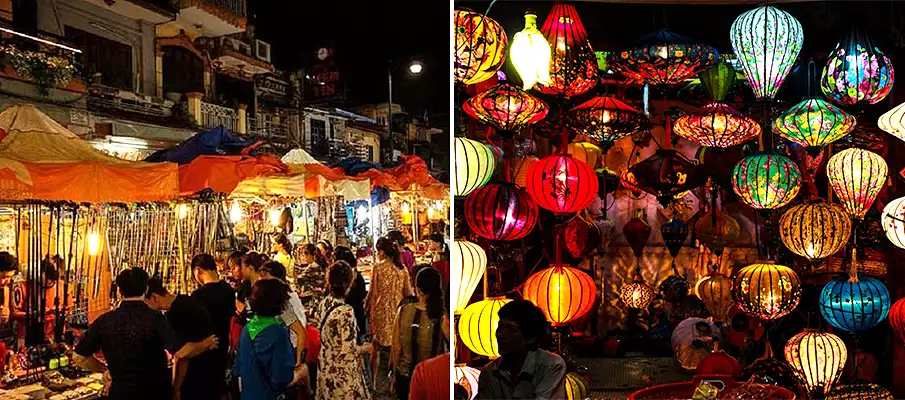
Why to visit or not to visit Hoi An Ancient Town?
Whether or not to visit Hoi An Ancient Town depends on your interests and preferences. Here are some reasons why you might want to visit or not visit Hoi An town:
👉 Reasons to visit Hoi An:
-
- Cultural heritage: Hoi An Ancient Town is a unique blend of Chinese, Japanese, and European influences, which is reflected in its architecture, customs, and traditions. Visitors can explore the old town’s historical sites, museums, and temples to learn more about its rich cultural heritage.
- Shopping: Hoi An Ancient Town is famous for its tailor-made clothing, shoes, and accessories, making it a great destination for those who love shopping. Visitors can also browse through local markets and shops to buy souvenirs and handicrafts.
- Food: Hoi An Ancient Town is a food lover’s paradise, with a wide variety of local and international cuisines to choose from. From street food stalls to fine-dining restaurants, visitors can indulge in the town’s famous dishes such as Cao Lau, Banh Mi, and Com Ga.
👉 Reasons not to visit Hoi An:
-
- Crowds: Hoi An Ancient Town is a popular destination, and it can get crowded during peak tourist season. Visitors may need to be prepared to navigate through crowds and wait in long queues.
- Weather: The weather in Hoi An can be hot and humid, especially during the summer months. Visitors may need to plan their visit accordingly and stay hydrated.
- Cost: Hoi An Ancient Town can be relatively expensive compared to other destinations in Vietnam due to its popularity and tourist facilities. Visitors may need to be prepared to pay more for accommodation, food, and transportation.
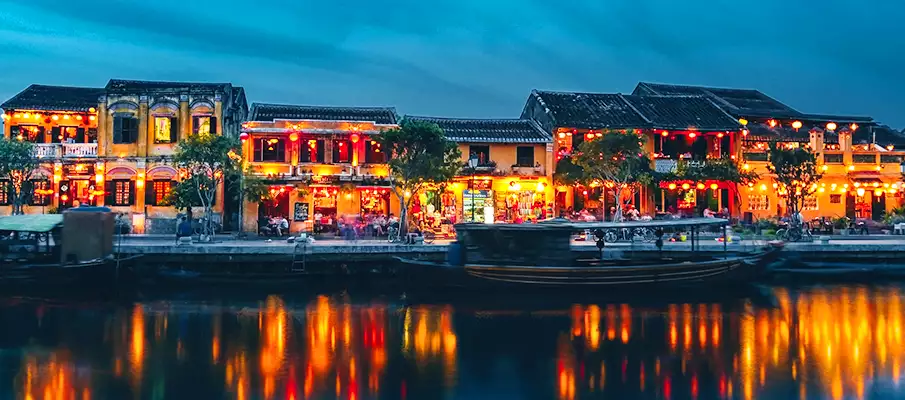
Exploring the Local Food and Cuisine in Hoi An:
Hoi An’s cuisine is a fusion of Vietnamese, Chinese, and European influences, making it a unique and delicious culinary destination. Some of the most popular dishes include:
1. Cao Lau: is a traditional Vietnamese noodle dish that originated in Hoi An. It’s made with thick rice noodles that have been flavored with ash water, which gives them a unique texture and color. The noodles are then topped with slices of roast pork, fresh herbs, and crispy rice crackers.
2. Banh Mi: a Vietnamese-style sandwich filled with a variety of ingredients, such as grilled pork, pate, pickled vegetables, and chili sauce, served on a crusty baguette.
3. White Rose Dumplings: a delicate and flavorful dish made with shrimp and pork wrapped in a translucent rice paper and shaped to look like a white rose.
4. Mi Quang: a noodle dish originating from the Quang Nam province, featuring a rich and spicy broth made with turmeric, chili, and lemongrass, served with pork, shrimp, and fresh herbs.
5. Com Ga: a simple yet delicious dish made with shredded chicken served on a bed of fragrant rice, accompanied by herbs, pickles, and a chili sauce.
In addition to these popular dishes, Hoi An is also known for its street food scene, with numerous food vendors and markets offering a variety of local specialties, such as Banh Xeo (crispy rice pancakes filled with shrimp and pork) and Che (sweet dessert soups made with beans, fruit, and coconut milk). Hoi An’s food scene is a must-try for any foodie visiting Vietnam, offering a unique and delicious blend of flavors and ingredients that reflect the town’s rich history and culture.
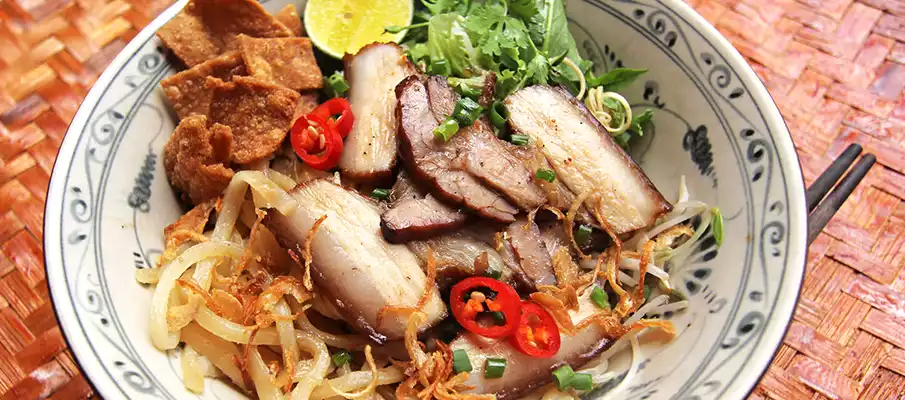
✈️ How to get and travel to Hoi An?
Hoi An is located in central Vietnam and can be reached by various modes of transportation. A lot of tourists travel to Hoi An via Da Nang. Here are some options for getting to Hoi An:
-
- 1. By Air: The closest airport to Hoi An is Da Nang International Airport, which is about 30 km away. Many major airlines offer direct flights to Da Nang from cities like Hanoi, Ho Chi Minh City, and Bangkok. From the airport, you can take a taxi or shuttle bus to Hoi An. This is the most comfortable option of transfer to Hoi An.
- 2. By Train: Hoi An does not have its own train station, but you can take a train to nearby Da Nang and then continue to Hoi An by private taxi or bus. The train journey from Hanoi or Ho Chi Minh City to Da Nang takes around 16-20 hours, depending on the route.
- 3. By Bus: Hoi An is well-connected by bus to major cities in Vietnam, including Da Nang, Hue, Hanoi, and Ho Chi Minh City. Many bus companies offer both day and night buses, with journey times ranging from a few hours to overnight. But this is not so comfortable option of transfer.
- You can book and buy tickets / cars to Hoi An in Vietnam on Baolau ➜ or 12go.asia ➜.

☀️ Weather in Hoi An + The Best Time to Visit:
-
- Hoi An has a tropical climate with two main seasons: a wet season and a dry season. The wet season lasts from September to January, with heavy rainfalls and occasional typhoons. The dry season runs from February to August, with hot and humid weather.
-
- The best time to visit Hoi An is during the dry season, especially from February to May when the weather is mild and pleasant. The temperatures are cooler, and the skies are clear, making it ideal for outdoor activities and exploring the ancient town. June to August is also a good time to visit, but it can be quite hot and humid.
- The average temperature in Hoi An ranges from 25°C to 30°C throughout the year, with the hottest months being June to August. During this time, the temperature can rise to 35°C, and the humidity can be quite high, making it feel even hotter.
- The wet season in Hoi An, from September to January, can bring heavy rainfall and occasional typhoons, particularly in October and November. However, the rains are usually short-lived and do not last all day. The wet season also brings a lush greenery to the countryside and rice fields, which can be a beautiful sight to see. If you are planning to visit during the wet season, be prepared for occasional rain and storms, but also take advantage of lower hotel rates and fewer tourists. ➜ Current weather in Hoi An.
| Month | Weather | Description |
|---|---|---|
| January | Cool and Dry | In January, Hoi An experiences cool and dry weather. The average high temperature is around 24°C (75°F), and the low temperature is approximately 19°C (66°F). It’s an ideal time for exploring the ancient town’s historic architecture, lantern-lit streets, and vibrant markets. |
| February | Cool and Dry | February continues with cool and dry conditions. The average high temperature remains around 25°C (77°F), and lows are around 20°C (68°F). The comfortable weather is perfect for wandering through the charming streets, enjoying boat rides along the Thu Bon River, and trying local cuisine. |
| March | Mild and Dry | March brings mild and dry weather to Hoi An. The average high temperature is about 28°C (82°F), and lows are around 22°C (72°F). It’s a wonderful time to explore nearby islands, relax on An Bang Beach, and participate in the Hoi An Lantern Festival. |
| April | Warm and Dry | In April, Hoi An experiences warm and dry conditions. The average high temperature is around 31°C (88°F), and lows are approximately 24°C (75°F). It’s an excellent time for outdoor activities like exploring the My Son Sanctuary and enjoying the beautiful countryside. |
| May | Warm and Humid | May continues with warm and humid weather. The average high temperature hovers around 34°C (93°F), and lows are around 26°C (79°F). The humidity increases as the monsoon season approaches. Despite occasional showers, May offers lush landscapes and vibrant local life to explore. |
| June | Hot and Humid | June experiences hot and humid weather. The average high temperature is about 36°C (97°F), and lows are approximately 27°C (81°F). The rainfall increases, but there are also periods of sunshine. June is a quieter month, allowing for a relaxed exploration of local culture. |
| July | Hot and Humid | July remains hot and humid in Hoi An. The average high temperature is around 37°C (99°F), and lows are around 27°C (81°F). The rain is more frequent, but it usually comes in short bursts. July is a good time to explore local markets and participate in eco-tourism activities. |
| August | Hot and Humid | August continues with hot and humid weather. The average high temperature hovers around 37°C (99°F), and lows are around 27°C (81°F). The rainfall is more consistent, but it rarely affects travel plans. August is an ideal time to visit nearby islands and relax on the beaches. |
| September | Hot and Humid | September experiences hot and humid weather, with an average high of about 35°C (95°F) and lows of 26°C (79°F). The rain is more frequent, but it usually comes in short, refreshing showers. It’s a good time to explore local markets and indulge in Hoi An’s culinary delights. |
| October | Warm and Dry | October continues with warm and dry conditions. The average high temperature is around 31°C (88°F), and lows are around 24°C (75°F). The weather is suitable for exploring Hoi An’s ancient town, visiting the Fujian Assembly Hall, and enjoying boat rides on the river. |
| November | Cool and Dry | In November, Hoi An experiences cool and dry weather. The average high temperature remains around 28°C (82°F), and lows are around 22°C (72°F). The comfortable weather makes it an excellent time for beach activities, visiting the Tra Que Vegetable Village, and exploring the local markets. |
| December | Cool and Dry | December brings cool and dry weather to Hoi An. The average high temperature hovers around 25°C (77°F), and lows are about 19°C (66°F). It’s a great time to explore the lantern-lit streets during the Hoi An Lantern Festival and engage in cultural experiences. |

🏡 Accommodation in Hoi An / Where to Stay:
-
- Hoi An has a range of accommodation options to suit every budget and travel style. From budget-friendly hostels to luxury resorts, there’s something for everyone in Hoi An.
- If you’re looking for a budget-friendly option, there are plenty of hostels and guesthouses located in the old town and nearby areas. These accommodations offer basic amenities like air conditioning, Wi-Fi, and shared bathrooms, and are perfect for backpackers and budget-conscious travelers.
- For mid-range options, there are plenty of boutique hotels and homestays located in the old town and surrounding areas. These properties offer comfortable rooms with private bathrooms, air conditioning, and some may also include breakfast and swimming pools.
- If you’re looking for luxury accommodations, there are several high-end resorts and hotels located along the beaches and rivers in Hoi An. These properties offer top-notch amenities like private pools, spas, and gourmet restaurants. Additionally, there are also many Airbnb and vacation rental options available in Hoi An, which can be a great choice for families and groups who want more space and privacy.
➜ Accommodation in Hoi An – Book Here
🔍 Interesting Places + Activities in Hoi An:
-
- Japanese Covered Bridge: This historic bridge, built in the 16th century, is one of the most significant landmarks in Hoi An. It connects two parts of the city, and its unique architecture blends Japanese and Vietnamese styles. The bridge is adorned with sculptures and reliefs and is often illuminated with traditional lanterns.
- Hoi An Ancient Town: Strolling through the narrow streets of the old town is like stepping back in time. Historical buildings, temples, and traditional houses reflect the mix of cultures that have influenced the city. Each step takes you into the past when Hoi An was a bustling port.
- An Bang and Cua Dai Beaches: These beaches offer not only relaxation on white sands and swimming in azure waters but also a tranquil atmosphere. Surrounded by restaurants and bars, you can enjoy refreshing cocktails while lounging by the sea.
- Cam Thanh Monastery: A serene monastery located just outside the city offers a refuge for those seeking meditation and tranquility. Beautifully maintained gardens and ponds create a soothing ambiance.
- Hoi An Memories Land: This immersive attraction offers visitors a journey through time, showcasing the rich history, traditions, and culture of Hoi An. It features historical replicas, a mesmerizing lantern garden, live cultural performances, and authentic Vietnamese cuisine, making it a must-visit destination for those seeking to experience the essence of Hoi An’s heritage.
- Thanh Ha Pottery Village: Thanh Ha Pottery Village is a historic and culturally significant village located near Hoi An, a picturesque town in central Vietnam. This village is renowned for its long-standing tradition of pottery-making, dating back centuries. Thanh Ha is a place where skilled artisans craft a wide variety of ceramic products, including decorative items, cookware, and everyday household items.
- Museum of Folk Culture: Museum of Folk Culture aims to showcase the everyday lives of the humble Hoi an folk individuals.
- My Son Sanctuary: This ancient complex of Hindu temples is listed as a UNESCO World Heritage site and provides insights into the region’s rich history and religious beliefs. Each detail of these ornate structures tells its own story.
- Hoi An Markets: Local markets offer goods such as fresh fruits, vegetables, fish, and more. It’s a great place to taste local specialties and shop for souvenirs.
- Cham Islands: These islands are a perfect spot for beach relaxation, diving, or snorkeling. Visit local villages and discover the Cham culture.
- Tra Que Vegetable Village: Experience what it’s like to work on a farm, plant and harvest vegetables. Witness how local farmers cultivate food.
- VinWonders Nam Hoi An: VinWonders Nam Hoi An is a sprawling amusement park and resort in Hoi An, Vietnam, known for its thrilling rides, water park, cultural experiences, and beautiful coastal setting, making it a must-visit destination for travelers seeking fun and relaxation.
- Hoi An Water Puppet Show: Water puppetry involves puppeteers manipulating wooden puppets that appear to „perform“ on the surface of a water stage. The stage is a large pool of water, and the puppeteers stand behind a bamboo screen to control the puppets with long, submerged poles and strings hidden beneath the water.
- Lantern Festival: Every month, thousands of traditional lanterns are lit during the festival, illuminating the streets and the river. The atmosphere is enchanting and romantic, creating an unforgettable experience.
- Cultural Performances: Theater performances provide insights into Vietnam’s rich history and culture. Traditional dances and music revive ancient traditions and stories.
- Cooking Classes: Learn to prepare traditional Vietnamese dishes under the guidance of local chefs. It’s a fun experience filled with tasting and acquiring new skills.
- Thu Bon River Boat Ride: A boat ride on the river offers a different perspective of the city and its surroundings. You’ll see traditional fishing boats and beautiful views of the riverbanks.
- Lantern-Making Workshops: Learn a traditional artistic skill and get a glimpse into how colorful lanterns, which decorate the city, are made.
- Shopping Experiences: The city is known for its traditional fabrics, tailor-made clothing, jewelry, and pottery. Discover handmade products as souvenirs of your stay.
- Biking Tour: Rent a bicycle and embark on a rural tour. You’ll pass through picturesque villages, rice fields, and see how local people live. This is a great way to get acquainted with the local culture and nature.
📍 Hoi An + Cham Islands – Google Map:
❓ Frequently asked questions + Travel Tips for Hoi An:
1. How to book and buy train / bus tickets or flights to Hoi An?
2. What is the best time to visit Hoi An?
-
- The best time to visit Hoi An is from February to April or from August to October, as the weather is mild and dry. Avoid visiting during the rainy season from September to January, as floods and storms can occur.
3. What are the must-see attractions in Hoi An?
-
- Discover the must-see attractions in Hoi An, including the iconic Japanese Covered Bridge, the well-preserved Hoi An Ancient Town, the beautiful An Bang Beach, the ancient My Son Sanctuary, the vibrant Hoi An Night Market, and the charming Tra Que Vegetable Village. Plan to spend a few days exploring these attractions to fully experience the unique culture and beauty of Hoi An.
4. What is the cuisine like in Hoi An?
-
- Hoi An is famous for its Cao Lau noodles, Banh Mi sandwiches, and fresh seafood dishes. The cuisine is a mix of Vietnamese, Chinese, and Japanese influences.
5. Can I rent a bicycle in Hoi An?
-
- Yes, renting a bicycle is a popular way to explore Hoi An. Many hotels and guesthouses offer bicycle rentals, or you can rent one from a local shop.
6. What are some popular activities to do in Hoi An?
-
- Some popular activities in Hoi An include taking a cooking class, visiting local markets, exploring the countryside by bicycle, and taking a boat tour of the Thu Bon River.
7. Is Hoi An safe for solo travelers?
-
- Hoi An is generally a safe city for solo travelers. Violent crime is rare, but petty crime such as pickpocketing and theft can occur in crowded areas. As with any destination, it’s important to take basic safety precautions, such as keeping your valuables secure and being aware of your surroundings.
8. Can I use credit cards in Hoi An?
-
- While some upscale hotels, restaurants, and shops in Hoi An accept credit cards, it’s generally recommended to carry cash as many places only accept cash payment. ATMs are widely available throughout the city, and it’s recommended to withdraw Vietnamese dong to avoid high transaction fees.
9. Can I rent a motorbike in Hoi An?
-
- Yes, motorbike rental is a popular and convenient way to explore Hoi An and the surrounding areas. Many hotels and guesthouses offer motorbike rental services, and there are also numerous rental shops located throughout the city. It’s important to have a valid international driver’s license and wear a helmet while driving.
10. What are some unique souvenirs to purchase in Hoi An?
-
- Hoi An is known for its handcrafted lanterns, silk textiles, and woodblock prints. Other popular souvenirs include locally made pottery, traditional Vietnamese paintings, and Ao Dai (traditional Vietnamese dresses). The Hoi An Night Market and the Central Market are great places to shop for souvenirs.
11. Where to stay in Hoi An Ancient Town?
-
- There are various accommodation options in and around Hoi An Ancient Town, depending on your budget and preferences. If you want to stay in the heart of the town, you can choose from a range of hotels and homestays, many of which are housed in old shophouses and feature traditional Vietnamese architecture.
12. How to get to Cham Islands from Hoi An?
-
- To get to Cham Islands, you need to take a boat or ferry from Cua Dai Beach in Hoi An. The journey takes about 30 minutes to 1 hour, depending on the type of boat you choose. There are several tour operators that offer half-day or full-day tours to Cham Islands, which usually include round-trip transportation, a guide, snorkeling equipment, and lunch. You can also hire a private boat to take you to Cham Islands, but it can be more expensive than joining a tour.
13. What is My Son?
-
- My Son is an archaeological site located in Central Vietnam, about 40 kilometers southwest of Hoi An. It was once the religious and political center of the Champa Kingdom, which ruled over the area from the 4th to the 13th century. My Son is home to over 70 temples and towers, which were constructed between the 7th and 13th centuries, and are some of the most well-preserved examples of Hindu architecture in Southeast Asia.
14. How to travel from Hoi An to Da Nang?
-
- From Hoi An to Da Nang you can travel by bus, minivan or private car/taxi, Grab. Travel time is about 30-60 minutes.
15. Where you can go from Hoi An?
-
- From Hoi An you can travel to southern Vietnam, e.g. you can go to Quy Nhon or you can also visit Nha Trang – another popular and large beach city. There are direct flights to Nha Trang from Da Nang Airport.
16. What are the most popular and beautiful islands in Vietnam?
-
- Vietnam has a lot of beautiful islands also accessible for tourists. One of the most popular is Phu Quoc in southern Vietnam, but you should carefully read this article about 10 Best Islands in Vietnam.
17. How to travel solo in Vietnam?
-
- Discover the wonders of solo travel in Vietnam as you explore ancient temples, cruise through scenic landscapes or karst sceneries, hike various national parks and ethnic villages and connect with the warm-hearted locals, creating a personalized journey of cultural immersion and breathtaking experiences.
BOOK a TOUR / TICKETS in Hoi An ➜
| Interesting Facts about Hoi An: | Description |
|---|---|
| Hoi An’s Ancient Charm: | Hoi An is a captivating ancient town located in Quang Nam Province, Vietnam. With a history dating back to the 15th century, this well-preserved town was once a bustling international trading port. Hoi An’s historic charm is evident in its unique blend of architectural styles, reflecting Vietnamese, Chinese, and Japanese influences. The town’s narrow, lantern-lit streets, ancient houses, and picturesque canals create an enchanting atmosphere that draws history enthusiasts and travelers from around the world. Hoi An’s Old Town is a testament to its rich heritage and is often referred to as an open-air museum. |
| UNESCO World Heritage Site: | In 1999, Hoi An’s Old Town was designated as a UNESCO World Heritage Site, recognizing its cultural and historical significance. This prestigious status has played a pivotal role in preserving the town’s unique character and promoting sustainable tourism. Hoi An’s Old Town, with its exceptionally well-preserved buildings, traditional way of life, and rich cultural heritage, offers visitors a rare opportunity to step back in time and explore Vietnam’s history in a living, breathing context. |
| Floating Lanterns on the Thu Bon River: | One of the most enchanting traditions in Hoi An is the mesmerizing sight of floating lanterns on the Thu Bon River. On the 14th day of each lunar month, the town turns off its electric lights, and thousands of colorful lanterns are gently released into the river. This tradition creates a magical and tranquil atmosphere, making Hoi An famous for its Full Moon Lantern Festival. The soft glow of the lanterns, combined with the reflections on the water, offers a truly captivating experience that symbolizes peace and harmony. |
| Hoi An’s Culinary Heritage: | Hoi An is celebrated for its diverse and delectable cuisine. The town’s food culture is a delightful blend of Vietnamese, Chinese, and Japanese influences, a reflection of its historical role as a trading port. Visitors can embark on a culinary adventure, sampling a wide array of local dishes. Among the must-try specialties are „Cao Lau,“ a savory noodle dish unique to Hoi An, and „White Rose Dumplings,“ delicate shrimp dumplings that are a local delicacy. The town’s vibrant street food scene and bustling markets provide an opportunity to savor the flavors of Hoi An’s rich culinary heritage. |
| The Japanese Covered Bridge: | One of Hoi An’s iconic landmarks is the Japanese Covered Bridge, known locally as „Chua Cau“ or „Lai Vien Kieu.“ This beautiful wooden bridge, with its intricate carvings and a small temple on one side, was constructed in the 18th century. The bridge’s architecture is a testament to the influence of Japanese traders in Hoi An during this period. The bridge not only connects two parts of the town but also serves as a symbol of the town’s unity and cultural fusion. It’s a must-visit attraction that offers a glimpse into the historical ties between Hoi An and Japan. |
| The Traditional Tailors: | Hoi An is often referred to as the tailoring capital of Vietnam. The town is renowned for its skilled tailors who can create custom-made clothing within a day or two. Visitors can choose from a vast selection of fabrics, from silks to linens, and have suits, dresses, shirts, and other garments tailored to their exact specifications. Hoi An’s tailoring tradition dates back centuries to its time as a thriving trading port, and it continues to thrive today. The combination of quality craftsmanship, quick turnaround, and reasonable prices makes it a popular destination for those seeking bespoke clothing. |
| Hoi An’s Lantern Festival: | One of the most anticipated events in Hoi An is the Lantern Festival, which takes place on the night of the full moon. During this enchanting festival, the entire town is adorned with colorful lanterns. The streets are closed to motorized traffic, creating a pedestrian-friendly environment. The festival is a celebration of Hoi An’s cultural heritage, with traditional performances, games, and food stalls lining the streets. Visitors can participate in releasing their lanterns into the river, adding to the magical ambiance. It’s a wonderful time to experience the town’s vibrant culture and immerse yourself in its rich traditions. |
| My Son Sanctuary: | A short drive from Hoi An, the My Son Sanctuary is a complex of ancient Hindu temples built by the Champa Kingdom between the 4th and 14th centuries. These temples, constructed with intricate carvings and stunning architecture, are a testament to the historical and cultural significance of the Champa civilization. My Son is another UNESCO World Heritage Site and offers a fascinating glimpse into the region’s history. It’s a must-visit for history buffs and those interested in exploring Vietnam’s ancient past. |
| Hoi An’s Beautiful Beaches: | Hoi An is not just a town of historical and cultural significance; it also boasts stunning beaches. Cua Dai Beach and An Bang Beach are popular choices for relaxation and water sports. These pristine sandy shores are perfect for unwinding and enjoying the tranquil beauty of the South China Sea. Hoi An’s unique appeal lies in its combination of cultural exploration and beachside relaxation, making it a well-rounded destination for all types of travelers. |
Book your Accommodation in Hoi An ➜
Hue – Travel Guide|Phong Nha – Travel Guide|Thanh Hoa – Travel Guide|Battambang to Bangkok|Krabi to Koh Jum Island|Weather in Nha Trang
